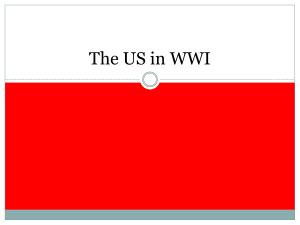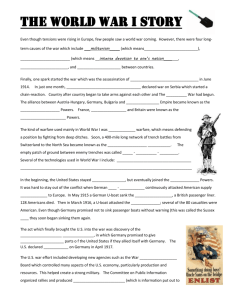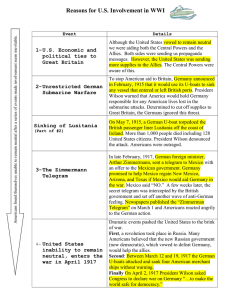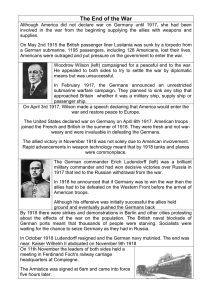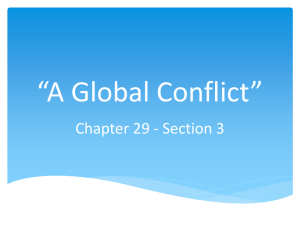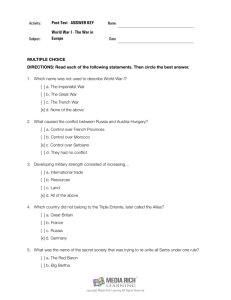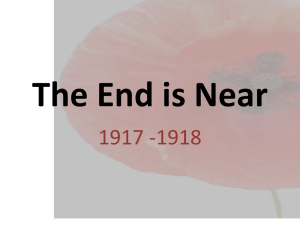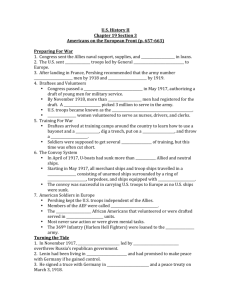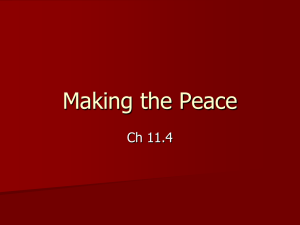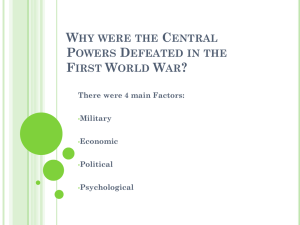Modern European History Unit 7 – Nation-Building and War
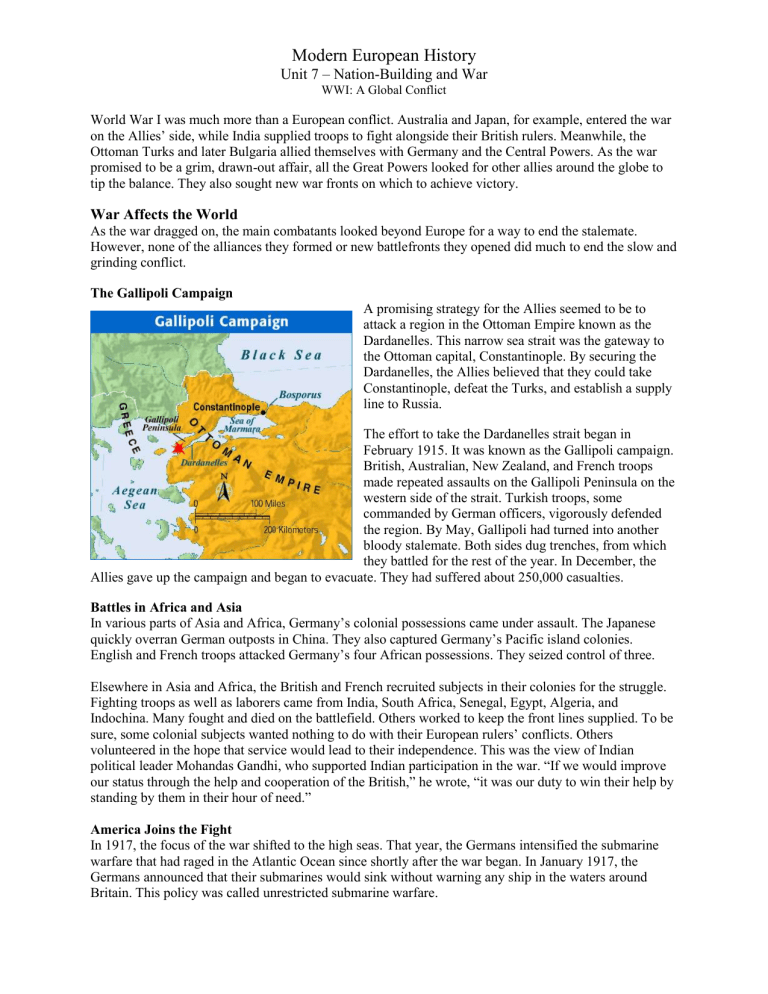
Modern European History
Unit 7 – Nation-Building and War
WWI: A Global Conflict
World War I was much more than a European conflict. Australia and Japan, for example, entered the war on the Allies’ side, while India supplied troops to fight alongside their British rulers. Meanwhile, the
Ottoman Turks and later Bulgaria allied themselves with Germany and the Central Powers. As the war promised to be a grim, drawn-out affair, all the Great Powers looked for other allies around the globe to tip the balance. They also sought new war fronts on which to achieve victory.
War Affects the World
As the war dragged on, the main combatants looked beyond Europe for a way to end the stalemate.
However, none of the alliances they formed or new battlefronts they opened did much to end the slow and grinding conflict.
The Gallipoli Campaign
A promising strategy for the Allies seemed to be to attack a region in the Ottoman Empire known as the
Dardanelles. This narrow sea strait was the gateway to the Ottoman capital, Constantinople. By securing the
Dardanelles, the Allies believed that they could take
Constantinople, defeat the Turks, and establish a supply line to Russia.
The effort to take the Dardanelles strait began in
February 1915. It was known as the Gallipoli campaign.
British, Australian, New Zealand, and French troops made repeated assaults on the Gallipoli Peninsula on the western side of the strait. Turkish troops, some commanded by German officers, vigorously defended the region. By May, Gallipoli had turned into another bloody stalemate. Both sides dug trenches, from which they battled for the rest of the year. In December, the
Allies gave up the campaign and began to evacuate. They had suffered about 250,000 casualties.
Battles in Africa and Asia
In various parts of Asia and Africa, Germany’s colonial possessions came under assault. The Japanese quickly overran German outposts in China. They also captured Germany’s Pacific island colonies.
English and French troops attacked Germany’s four African possessions. They seized control of three.
Elsewhere in Asia and Africa, the British and French recruited subjects in their colonies for the struggle.
Fighting troops as well as laborers came from India, South Africa, Senegal, Egypt, Algeria, and
Indochina. Many fought and died on the battlefield. Others worked to keep the front lines supplied. To be sure, some colonial subjects wanted nothing to do with their European rulers’ conflicts. Others volunteered in the hope that service would lead to their independence. This was the view of Indian political leader Mohandas Gandhi, who supported Indian participation in the war. “If we would improve our status through the help and cooperation of the British,” he wrote, “it was our duty to win their help by standing by them in their hour of need.”
America Joins the Fight
In 1917, the focus of the war shifted to the high seas. That year, the Germans intensified the submarine warfare that had raged in the Atlantic Ocean since shortly after the war began. In January 1917, the
Germans announced that their submarines would sink without warning any ship in the waters around
Britain. This policy was called unrestricted submarine warfare.
The Germans had tried this policy before. On May 7, 1915, a
German submarine, or U-boat, had sunk the British passenger ship Lusitania. The attack left 1,198 people dead, including 128
U.S. citizens. Germany claimed that the ship had been carrying ammunition, which turned out to be true. Nevertheless, the
American public was outraged. President Woodrow Wilson sent a strong protest to Germany. After two further attacks, the Germans finally agreed to stop attacking neutral and passenger ships.
Desperate for an advantage over the Allies, however, the Germans returned to unrestricted submarine warfare in 1917. They knew it might lead to war with the United States. They gambled that their naval blockade would starve Britain into defeat before the United States could mobilize. Ignoring warnings by
President Wilson, German U-boats sank three American ships.
In February 1917, another German action pushed the United States closer to war. Officials intercepted a telegram written by Germany’s foreign secretary, Arthur Zimmermann, stating that Germany would help
Mexico “reconquer” the land it had lost to the United States if Mexico would ally itself with Germany.
The Zimmermann note simply proved to be the last straw. A large part of the American population already favored the Allies. In particular, America felt a bond with England. The two nations shared a common ancestry and language, as well as similar democratic institutions and legal systems. More important, America’s economic ties with the Allies were far stronger than those with the Central Powers.
On April 2, 1917, President Wilson asked Congress to declare war on Germany. The United States entered the war on the side of the Allies.
The Zimmermann Note Berlin, January 19, 1917
On January 19, 1917, Arthur Zimmermann, the
German foreign secretary, sent the following coded telegram to the German ambassador in Mexico.
British intelligence agents decoded the telegram and passed it on to the U.S. government.
On the first of February we [Germany] intend to begin submarine warfare unrestricted. In spite of this it is our intention to keep neutral the United
States of America.
If this attempt is not successful we propose an alliance on the following basis with Mexico: That we shall make war together and together make peace. We shall give general financial support, and it is understood that Mexico is to reconquer the lost territory in New Mexico, Texas, and Arizona. The details are left for your settlement.
You are instructed to inform the President of Mexico of the above in the greatest confidence as soon as it is certain there will be an outbreak of war with the United States, and we suggest that the President of Mexico on his own initiative should communicate with Japan suggesting adherence at once to this plan; at the same time offer to mediate between Germany and Japan.
Please call to the attention of the President of Mexico that the employment of ruthless submarine warfare now promises to compel England to make peace in a few months.
Zimmermann.
2
War Affects the Home Front
By the time the United States joined the Allies, the war had been raging for nearly three years. In those three years, Europe had lost more men in battle than in all the wars of the previous three centuries. The war had claimed the lives of millions and had changed countless lives forever. The Great War, as the conflict came to be known, affected everyone. It touched not only the soldiers in the trenches, but civilians as well.
Governments Wage Total War
World War I soon became a total war. This meant that countries devoted all their resources to the war effort. In Britain, Germany, Austria, Russia, and France, the entire force of government was dedicated to winning the conflict. In each country, the wartime government took control of the economy. Governments told factories what to produce and how much.
Women and the War
Total war meant that governments turned to help from women as never before. Thousands of women replaced men in factories, offices, and shops. Women built tanks and munitions, plowed fields, paved streets, and ran hospitals.
They also kept troops supplied with food, clothing, and weapons. Although most women left the work force when the war ended, they changed many people’s views of what women were capable of doing.
Women also saw the horrors of war firsthand, working on or near the front lines as nurses.
Here, American nurse Shirley Millard describes her experience with a soldier who had lost both eyes and feet:
He moaned through the bandages that his head was splitting with pain. I gave him morphine.
Suddenly aware of the fact that he had [numerous] wounds, he asked: “Sa-ay! What’s the matter with my legs?” Reaching down to feel his legs before I could stop him, he uttered a heartbreaking scream. I held his hands firmly until the drug I had given him took effect.
~Shirley Millard, I Saw Them Die ~
The Influenza Epidemic
In the spring of 1918, a powerful new enemy emerged, threatening nations on each side of World War I. This “enemy” was a deadly strain of influenza. The
Spanish flu, as it was popularly known, hit
England and India in May. By the fall, it had spread through Europe, Russia, Asia, and to the United States.
The influenza epidemic killed soldiers and civilians alike. In India, at least 12 million people died of influenza. In Berlin, on a single day in October, 1,500 people died.
In the end, this global epidemic was more
3
destructive than the war itself, killing 20 million people worldwide.
Numerous facilities were converted to munitions factories. Nearly every able-bodied civilian was put to work. Unemployment in many European countries all but disappeared.
So many goods were in short supply that governments turned to rationing. Under this system, people could buy only small amounts of those items that were also needed for the war effort. Eventually, rationing covered a wide range of goods, from butter to shoe leather.
Governments also suppressed antiwar activity, sometimes forcibly. In addition, they censored news about the war. Many leaders feared that honest reporting of the war would turn people against it. Governments also used propaganda, one-sided information designed to persuade, to keep up morale and support for the war.
The Allies Win the War
With the United States finally in the war, the balance, it seemed, was about to tip in the Allies’ favor.
Before that happened, however, events in Russia gave Germany a victory on the Eastern Front, and new hope for winning the conflict.
Russia Withdraws
In March 1917, civil unrest in Russia - due in large part to war-related shortages of food and fuel - forced Czar Nicholas to step down. In his place a provisional government was established. The new government pledged to continue fighting the war. However, by 1917, nearly 5.5 million Russian soldiers had been wounded, killed, or taken prisoner. As a result, the warweary Russian army refused to fight any longer.
Eight months after the new government took over, a revolution shook Russia.
In November 1917, Communist leader Vladimir Ilyich Lenin seized power.
Lenin insisted on ending his country’s involvement in the war. One of his first acts was to offer Germany a truce. In March 1918, Germany and Russia signed the Treaty of Brest-Litovsk, which ended the war between them.
The Central Powers Collapse
Russia’s withdrawal from the war at last allowed Germany to send nearly all its forces to the Western
Front. In March 1918, the Germans mounted one final, massive attack on the Allies in France. As in the opening weeks of the war, the German forces crushed everything in their path. By late May 1918, the
Germans had again reached the Marne River. Paris was less than 40 miles away. Victory seemed within reach.
By this time, however, the German military had weakened. The effort to reach the Marne had exhausted men and supplies alike. Sensing this weakness, the Allies—with the aid of nearly 140,000 fresh U.S. troops—launched a counterattack. In July 1918, the Allies and Germans clashed at the Second Battle of the Marne. Leading the Allied attack were some 350 tanks that rumbled slowly forward, smashing through the German lines. With the arrival of 2 million more American troops, the Allied forces began to advance steadily toward Germany.
Soon, the Central Powers began to crumble. First the Bulgarians and then the Ottoman Turks surrendered.
In October, revolution swept through Austria-Hungary. In Germany, soldiers mutinied, and the public turned on the kaiser.
On November 9, 1918, Kaiser Wilhelm II stepped down. Germany declared itself a republic. A representative of the new German government met with French Commander Marshal Foch in a railway
4
car near Paris. The two signed an armistice, or an agreement to stop fighting. On November 11, World
War I came to an end.
The Legacy of the War
World War I was, in many ways, a new kind of war. It involved the use of new technologies. It ushered in the notion of war on a grand and global scale. It also left behind a landscape of death and destruction such as was never before seen.
Both sides in World War I paid a tremendous price in terms of human life. About 8.5 million soldiers died as a result of the war. Another 21 million were wounded. In addition, the war led to the death of countless civilians by way of starvation, disease, and slaughter. Taken together, these figures spelled tragedy - an entire generation of Europeans wiped out.
The war also had a devastating economic impact on Europe. The great conflict drained the treasuries of
European countries. One account put the total cost of the war at $338 billion, a staggering amount for that time. The war also destroyed acres of farmland, as well as homes, villages, and towns.
The enormous suffering that resulted from the Great War left a deep mark on Western society as well. A sense of disillusionment settled over the survivors. The insecurity and despair that many people experienced are reflected in the art and literature of the time.
Another significant legacy of the war lay in its peace agreement. As you will read in the next section, the treaties to end World War I were forged after great debate and compromise. And while they sought to bring a new sense of security and peace to the world, they prompted mainly anger and resentment.
3.
4.
5.
6.
Answer each of the following questions thoroughly and in complete sentences on another sheet of paper.
1. What factors helped prompt the United States to join the war for the Allies?
2. According to the Zimmermann telegram, what was the German government going to begin on
February 1, 1917? What did Zimmermann propose if the United States went to war with Germany during World War I?
What role did women play in the war?
What was the significance of the Second Battle of the Marne?
In what ways was World War I truly a global conflict?
Do you think governments are justified in censoring war news? Why or why not?
5
6
